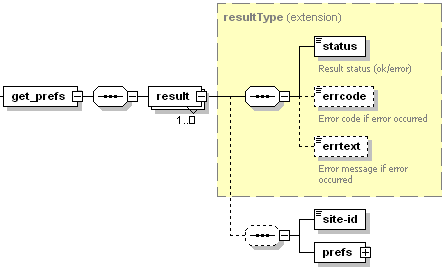Getting Mail Service Preferences
Use the set_prefs operation to retrieve mail service settings set for the specified sites.
Request Packet Structure
A request XML packet that asks for mail service settings for a certain site should include the get_prefs operation node:
<packet>
<mail>
<get_prefs>
...
</get_prefs>
</mail>
</packet>
The get_prefs node does not have a separate type, it is nested
within the MailTypeRequest type (mail_input.xsd). The
get_prefs node has the following graphics representation:

Note: The interactive schema navigator for all request packets is available here: http://plesk.github.io/api-schemas/1.6.9.1/agent_input.svg.
- The filter node is required. It holds a list of sites which mail service settings are requested. Data type: none.
- The site-id node is optional. It specifies an identifier of the site which mail service settings are requested. Data type: integer.
Note: When creating request packets, put nodes and elements in the order they follow in the packet structure. Otherwise you may get the error “Parse error. … This element is not expected.”
Response Packet Structure
The get_prefs node of the response packet is structured as follows:

Note: The interactive schema navigator for all response packets is available here: http://plesk.github.io/api-schemas/1.6.9.1/agent_output.svg.
- The result node is optional. It wraps the result of the
requested get_prefs operation. It can be missing if some error
occurs before the validation starts. Data type: resultType
(
common.xsd). - The status node is required. Returns the execution status of the get_prefs operation. Data type: string. Allowed values: ok | error.
- The errcode node is optional. Returns an error code when the get_prefs operation fails. Data type: unsignedInt.
- The errtext node is optional. Returns an error message if the get_prefs operation fails. Data type: string.
- The site-id node is optional. Returns the identifier of the site which mail service settings are retrieved. Data type: integer.
- The prefs node is optional. Returns a collection of mail
service preferences set for the specified site. Data type:
MailPreferences (
plesk_mail.xsd). The structure of the node is described in the Mail Service Settings section.
Samples
Getting Mail Service Preferences under Plesk Administrator
Plesk Administrator can get mail service preferences for all sites registered in Plesk.
Getting mail service preferences for particular sites
The following packet demonstrates how Plesk Administrator requests for mail service settings of three sites:
To get the mail service settings set for particular sites, use the following packet:
<packet>
<mail>
<get_prefs>
<filter>
<site-id>1</site-id>
<site-id>2</site-id>
<site-id>3</site-id>
</filter>
</get_prefs>
</mail>
</packet>
Response:
<packet>
<mail>
<get_prefs>
<result>
<status>ok</status>
<site-id>1</site-id>
<prefs>
<nonexistent-user>
<reject/>
</nonexistent-user>
<webmail>none</webmail>
<spam-protect-sign>false</spam-protect-sign>
<mailservice>true</mailservice>
</prefs>
</result>
<result>
<status>ok</status>
<site-id>2</site-id>
<prefs>
<nonexistent-user>
<reject/>
</nonexistent-user>
<webmail>none</webmail>
<spam-protect-sign>false</spam-protect-sign>
<mailservice>false</mailservice>
</prefs>
</result>
<result>
<status>ok</status>
<site-id>3</site-id>
<prefs>
<nonexistent-user>
<reject/>
</nonexistent-user>
<webmail>none</webmail>
<spam-protect-sign>false</spam-protect-sign>
<mailservice>true</mailservice>
</prefs>
</result>
</get_prefs>
</mail>
</packet>
To request these settings for all sites registered in Plesk, the following packet must be used:
<packet>
<mail>
<get_prefs>
<filter/>
</get_prefs>
</mail>
</packet>
Response:
<packet>
<mail>
<get_prefs>
<result>
<status>ok</status>
<site-id>1</site-id>
<prefs>
<nonexistent-user>
<reject/>
</nonexistent-user>
<webmail>none</webmail>
<spam-protect-sign>false</spam-protect-sign>
<mailservice>true</mailservice>
</prefs>
</result>
<result>
<status>ok</status>
<site-id>2</site-id>
<prefs>
<nonexistent-user>
<reject/>
</nonexistent-user>
<webmail>none</webmail>
<spam-protect-sign>false</spam-protect-sign>
<mailservice>false</mailservice>
</prefs>
</result>
<result>
<status>ok</status>
<site-id>3</site-id>
<prefs>
<nonexistent-user>
<reject/>
</nonexistent-user>
<webmail>none</webmail>
<spam-protect-sign>false</spam-protect-sign>
<mailservice>true</mailservice>
</prefs>
</result>
<result>
<status>ok</status>
<site-id>4</site-id>
<prefs>
<nonexistent-user>
<reject/>
</nonexistent-user>
<webmail>none</webmail>
<spam-protect-sign>false</spam-protect-sign>
<mailservice>true</mailservice>
</prefs>
</result>
</get_prefs>
</mail>
</packet>
Getting Email Service Settings under customer
All the use cases of the get_prefs operation for customers are similar to those for Plesk Administrator, described above. The only difference is that an empty filter means that the specified settings will be retrieved from all sites belonging to Plesk customer sending the packet:
<packet>
<mail>
<get_prefs>
<filter/>
</get_prefs>
</mail>
</packet>
Response:
<packet>
<mail>
<get_prefs>
<result>
<status>ok</status>
<site-id>1</site-id>
<prefs>
<nonexistent-user>
<reject/>
</nonexistent-user>
<webmail>none</webmail>
<spam-protect-sign>false</spam-protect-sign>
<mailservice>true</mailservice>
</prefs>
</result>
<result>
<status>ok</status>
<site-id>2</site-id>
<prefs>
<nonexistent-user>
<reject/>
</nonexistent-user>
<webmail>none</webmail>
<spam-protect-sign>false</spam-protect-sign>
<mailservice>false</mailservice>
</prefs>
</result>
<result>
<status>ok</status>
<site-id>3</site-id>
<prefs>
<nonexistent-user>
<reject/>
</nonexistent-user>
<webmail>none</webmail>
<spam-protect-sign>false</spam-protect-sign>
<mailservice>true</mailservice>
</prefs>
</result>
<result>
<status>ok</status>
<site-id>4</site-id>
<prefs>
<nonexistent-user>
<reject/>
</nonexistent-user>
<webmail>none</webmail>
<spam-protect-sign>false</spam-protect-sign>
<mailservice>true</mailservice>
</prefs>
</result>
</get_prefs>
</mail>
</packet>